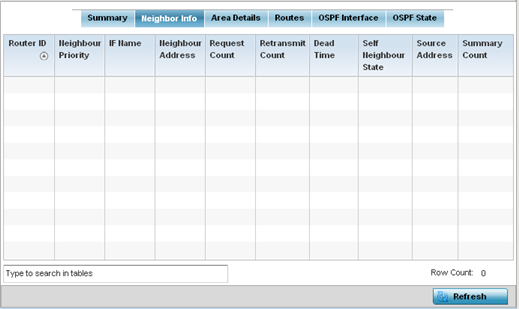OSPF Neighbors
OSPF establishes neighbor relationships to exchange routing updates with other routers. A controller or service platform supporting OSPF sends hello packets to discover neighbors and elect a designated router. The hello packet includes link state information and list of neighbors. OSPF is savvy with layer 2 topologies. If on a point-to-point link, OSPF knows it is sufficient, and the link stays up. If on a broadcast link, the router waits for election before determining if the link is functional.
To view OSPF neighbor statistics:
- Select the Statistics menu from the Web UI.
- Expand the RF Domain node.
- Select a Wireless Controller.
- Select OSPF from the left-hand side of the UI.
- Select the Neighbor Info
tab.
The screen displays.
 The screen provides the following information:
The screen provides the following information:Router ID Displays the router ID assigned for this OSPF connection. The router is a level three Internet Protocol packet switch. This ID must be established in every OSPF instance. If not explicitly configured, the highest logical IP address is duplicated as the router identifier. However, since the router identifier is not an IP address, it does not have to be a part of any routable subnet in the network.
Neighbor Priority Displays each listed neighbor's priority in respect to becoming the designated router managing the OSPF connection. The designated router is the router interface elected among all routers on a particular multi-access network segment.
IF Name Lists the name assigned to the router interface used to support connections amongst OSPF enabled neighbors.
Neighbor Address Lists the IP address of the neighbor sharing the router interface with each listed router ID.
Request Count Lists the connection request count (hello packets) to connect to the router interface, discover neighbors and elect a designated router.
Retransmit Count Lists the connection retransmission count attempted in order to connect to the router interface, discover neighbors and elect a designated router. A DR (designated router) is the router interface elected among all routers on a particular multi-access network segment, generally assumed to be broadcast.
Dead Time Lists the dead time between neighbors in the network topology that are currently utilizing the listed router ID.
Self Neighbor State Displays the self-neighbor status assessment used to discover neighbors and elect a designated router.
Source Address Displays the single source address used by all neighbor routers to obtain topology and connection status. This form of multicasting significantly reduces network load.
Summary Count Routes that originate from other areas are called summary routes. Summary routes are not flooded in a totally stubby or NSSA totally stubby area.
- Select Refresh to update the statistics counters to their latest values.

